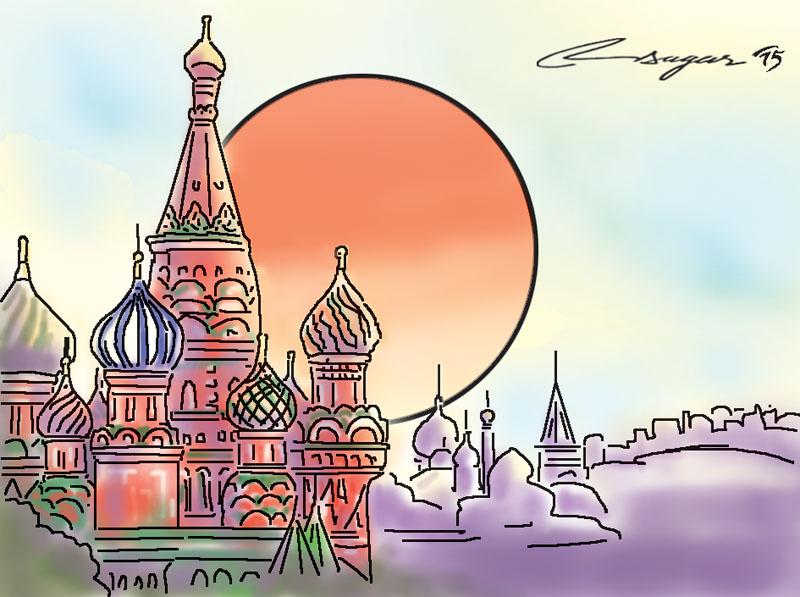From Moscow to Mussaria
In the inner Tarai region of Nawalparasi, Madhesis belonging to various parties, social organizations and fronts complained about Kathmandu’s apathy towards their agendas. In Palpa, in the hill region many saw the Tarai movement as a divisive one
It had been my long dream to visit Russia particularly Moscow, the seat of Kremlin which is so familiar to Communists all over the world. I had chance to visit Moscow in transit from UK to Nepal in 1995 when I was coming back to Nepal having finished my Master’s in Architecture in New Castle Upon Tyne in North UK. But what stopped me at that time was Russia was going through turmoil because of sudden shift to open liberal policy (from centralized Stalinist communist policy) taken by President Boris Yeltsin from 1991-1999 leading to chaos, corruption, lack of safety and uncertainty in politics as well as in economics. I was advised not to visit the country.
This year in November I got an invitation from Valentina Matvienko, the Speaker of the Federation Council of the Federal Assembly of the Russian Federation to attend the Eurasian Women’s Forum to be held on 23-24 September 2015. I accepted jubilantly, as I wanted to share our homegrown experience of making a constitution through the Constitution Assembly. More than that I wanted to go there primarily because it was the land of Lenin! Also I wanted to see Putin style capitalism in Russia as I had seen China with a communist system, USA with a presidential capitalist system and the UK with the Prime Ministerial capitalist system.
Putin had been marked as a President who not only revived economy of Russia but also helped put back Russia in a strong position in the world map.
When he became President for the first time he at first eased the market, but now he is said to be tightening the noose to put the economy under state control. Internationally he is also a person to reckon with because of his support for Syria’s Assad.
From the geographical point of view Russia is interesting with almost one fourth of its land falling under Europe and the rest under Asia. I was particularly keen to know how Balkanization of the Soviet Union to present Russia had occurred. Similarly I was also interested to know how annexation of Crimea to the Russian Federation had occurred in 2014. Both political events were important for us as we were exercising modalities of federalism in Nepal, which should stimulate inclusiveness and growth as well. At the time of my visit Russia was under economic sanction by EU. Some of the Nepalese doing small scale business were complaining they could not order materials coming from the EU. Just to see how the capital was different from rural areas I took a train to Saint Pittsburg from Moscow. I found that most of the rural houses were like the ones I saw in Europe, apparently both places fall under the European region.
In Saint Petersburg, also known as Petrograd, Leningrad, I went to see the winter and summer palace of Czar. Both were colossal, the winter palace was in the midst of city and the summer palace was far from the city. In both the places young beautiful women and handsome men dressed as Czars attracted tourists to take snaps with them.
After 10 days of my stay in Russia when I came back to Nepal I found Nepal in much different circumstances than when I left it. By then Madheshi and Tharu movements had taken a more aggressive posture. At that time I remembered how right Dr. Baburam Bhattarai had been in guessing that the movement may flare up.
By the time I came back to Nepal he had already taken trip to Janakpur to find out the ground reality of the movement in Tarai. He was taking a second trip to the Tarai region. I decide to go with him to tour Nawlaparasi, Butwal, Palpa, Nepalganj and Massuria in Kailali. Throughout the highway road I saw a few vehicles plying. Similarly few shops were open on both the sides of highway. In some places it had an eerie deserted look. I said to myself what a contrast to Moscow where roads were often jammed with shopping malls around the corners.
In the inner Tarai region of Nawalparasi, Madhesis belonging to various parties, social organizations and fronts complained about Kathmandu’s apathy towards their agendas. In Palpa, in the hill region many saw the Tarai movement as a divisive one.
Our trip to both Tarai and hills was embarrassing the ruling government. The reason being none of the Ministers, or parliamentarians nor ruling party leaders could dare to step in Tarai region to explore the situation there. Hence we were being discouraged in some form or the other. In Kailali in particular there was lot of pressure on us to prevent us from reaching the Massuria village in Kailali district. But we made it. The kind of mass I saw despite many being stopped on the way to Massuria by the administration was a mammoth rally. Tharus belonging to all parties, social organizations, women’s organizations numbering around 10,000 had participated. Tharus asserted that they were also equally involved in the Tarai movement and that it was they who had blocked the border between Nepal and India and vowed to continue it until their demands were met.
Reflecting back I said to myself what a contrast between my visit to Moscow and Mussuria. In Moscow I saw development in many fields. In MussuriaI saw paucity of development.
Coming back to Kathmandu on 8th October I found that Kathmandu had not yet woken up to the wake up call given by Tarai movement.






